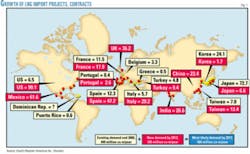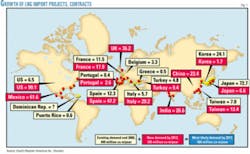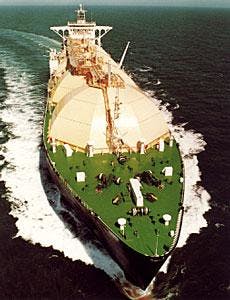World LNG trade responding to increased natural gas demand
Worldwide LNG trade will significantly increase over the next 20 years from the current 150 million tonnes/year (tpy) to in excess of 200 million tpy.
This increase will result from increasing world demand for clean burning fuels, particularly in regions where local production is insufficient such as the US and Northwest Europe, creating a requirement to import long-haul gas. The increase will also result from international and national oil companies and producing country governments having an imperative to monetize gas that cannot be utilized locally.
And finally, the increase will result from LNG projects becoming increasingly feasible as costs across the value chain are reduced, by as much as 30% over the last 20 years, due to economies of scale and efficiency gains.
Fig. 1 shows projections for the increase in the world LNG trade.
Liquefaction process
LNG has been produced for more than 60 years and has developed into a worldwide trade, primarily involving national and international oil companies as well as trading companies.
The process takes natural gas and cools it via compression to –160° C., shrinking the gas 1/600th of its original volume and making transportation by ship economical.
Due to the significant capital costs of an LNG liquefaction plant, there must be very large deposits of easily extractable natural gas to supply feedstock to it and most of the project output has generally had to be committed in long-term sales contracts before projects can receive funding, although this is gradually changing as the spot market has developed.
Today's new LNG facility will require certified natural gas reserves of more than 5 tcf in order to be considered for third party non-recourse financing and long-term gas sales contracts.
There are 20 export liquefaction plants currently in operation or under construction. Each plant has several process trains that are independent liquefaction units. There are at present 78 LNG trains in operation or under construction at existing plants. There are 15 new grassroots plants under discussion, but only Snøhvit (Norway), Damietta (Egypt), and Sakhalin (Russia) are under construction.
The other proposed plants await completion of sales and purchase agreements (SPAs). The liquefaction part of the LNG value chain is $800 million to $1 billion/train, including allocated tankage.
The cooling process can be achieved by one of several proprietary methods. Of the 78 LNG trains in operation or under construction, 57 use Air Products and Chemicals Inc.'s mixed refrigerant with propane precooling (C3MR) process. Of the remaining trains, 6 use Black & Veatch Pritchard Inc.'s Prico technology, 2 use Linde AG's, 7 use ConocoPhillips' cascade process, and 6 use Technip's Tealarc process.
LNG ships
The first long-distance shipment of LNG was in 1959 from the US Gulf of Mexico to the UK in the Methane Pioneer, a converted freighter. The first purpose-built LNG ships were the Methane Process and Methane Princess, built in the UK, classed by Lloyd's Register and commissioned in 1964 for British Gas to deliver LNG from Arzew, Algeria, to its regasification plant at Canvey Island, UK.
The fleet expanded to match import capacity, as LNG became a popular industrial fuel. Because of the high relative price of the LNG chain, the ships required long-term contracts in order to secure financing; this continues to be a major feature of the industry today.
Unexpectedly, demand for internationally traded LNG flattened in the mid 1980s, leaving some owners who had built ships speculatively with ships that had no employment upon delivery from the shipyards.
null
The reasons for this were the success of pipeline projects in Europe and government interference in pricing policy in the US. The principal market for LNG became Japan, a country with no indigenous supplies of petroleum products for energy generation.
Some of these ships found employment 5 years or so later, some were scrapped, and some were converted. Today, the world fleet stands at 194 ships and 23,404,355 cu m of capacity including existing and new ships. Ships range in size from 55,000 cu m to about 140,000 cu m, with the most common being in the 125,000 to 138,000 cu m in size.
Containment systems
As the fleet has grown, containment systems have polarized around three main systems in two generic types.
First, the independent system in which the cargo tanks are supported within the cargo hold (the main type is the spherical type designed by Moss Maitime AS), essentially manufactured aluminum spheres supported at the equator and with polyurethane foam insulation adhering to the tank.
A second type is the self-supporting prismatic (SPB) designed by IHI Marine Ltd.
Second is the membrane system in which the tank follows the structure of the hold. Following are the the two main systems:
- Gaz Transport with a thin extruded invar membrane supported by plywood boxes filled with perlite for insulation.
- Technigaz with a stainless steel formed membrane supported by polyurethane foam insulation.
All containment systems have both a primary and secondary containment barriers, are designed on the principle of "leak before failure," and will contain any leaking product for 15 days.
The International Maritime Organization (IMO) code for the carriage of liquefied gases in bulk specifies the design criterion for the ships. Primarily, four tanks are designed in each ship, but there are ships with five tanks. It is likely that for the larger ships currently on the drawing boards, a five-tank design will be adopted.
For some greenfield projects, economies of scale are being sought with much larger ships, up to 250,000 cu m. This may entail ships with draughts of the same order as current crude carriers.
Ship price; propulsion
The fleet began to grow again in the 1990s as global demand for shipments of LNG increased. Ships were very expensive at this time, up to $350 million/vessel.
In the late 1990s, Daewoo Heavy Industries (DHI) invested in an LNG ship factory concentrating upon the Gaz Transport system. Ship prices have fallen to around $160 million/vessel due to increased competition and productivity of the shipbuilders.
Steam propulsion has been used by most LNG ships because the boil-off gas can be burned as fuel in boilers as well as fuel oil. As shipbuilders have aimed to squeeze more capacity within the same hull dimensions, alternative propulsion systems are being proposed.
Dual-fuel diesels powering electric main propulsion motors are one of a number of reliable and more economic alternatives to steam. The first ship with such equipment is now under construction.
Regasification
The regasification terminals primarily involve a simple heat exchanger in which the LNG is warmed from –160° C. to 10° C.
Two methods of achieving this are used:
1.Seawater exchange called "open rack vaporizers" (ORV).
2.Warm-water bath that heats the water using natural gas called "submerged combustion vaporizers" (SCV). These units are used at more than 95% of existing regasification terminals.
Other methods, such as combined heat and power (CHP), are also used, especially if the facility can be integrated with a power plant. The facility could also be integrated very efficiently with any industrial facility such as a refinery or chemical plant.
There are more than 40 LNG regasification terminals in operation at present, with expansions of several under way. There are an additional 50 in various stages of discussion, with more than 40 being discussed for the North American market alone. Only a fraction of these proposed 40 terminals for the North American market are likely to come to be built, however, due to projected demand.
The cost for a typical LNG terminal with a nominal sendout capacity of 1 bcfd (7.5 million tpy of LNG at the inlet) is $250-500 million. The primary drivers of cost are the number and type of LNG tanks and the necessity for a breakwater.
Permitting and the "not in my backyard" public perception problem, especially in the US, are also leading drivers and the reasons many terminals under discussion will not be built.
Once LNG is regasified, the gas moves to end users, either an export gas pipeline, power plant, or other chemical plant or industrial user.
Editor's note: Information in this article complements and provides background for the poster of world LNG trade that will be published with the Dec. 1 issue of Oil & Gas Journal.
The authors
Al Kaplan is director, LNG, for Foster Wheeler USA Corp. He has more than 30 years' experience in project management of offshore oil and gas production facilities, pipelines, and LNG plants, including more than 20 years with Mobil Oil Corp. Kaplan holds a BS in civil engineering from the University of Missouri–Rolla and is a registered professional engineer in Louisiana and Missouri and a member of SPE.
Graham Marshall is vice-president for marine business support at Lloyd's Register Americas Inc., Houston. He began his career as a shipwright with Ocean Transport and Trading, Liverpool, and graduated from the University of Newcastle upon Tyne with a BSc (honors) in naval architecture and an MSc in marine technology. He then worked for the British Ship Research Association in various roles from technical consultancy through to commercial management and studied part time for an MBA at the University of Durham. He joined Lloyd's Register in 1993 to lead the ShipRight product development team, was subsequently employed for general marine marketing at its London headquarters, and transferred to Houston in 1998.




